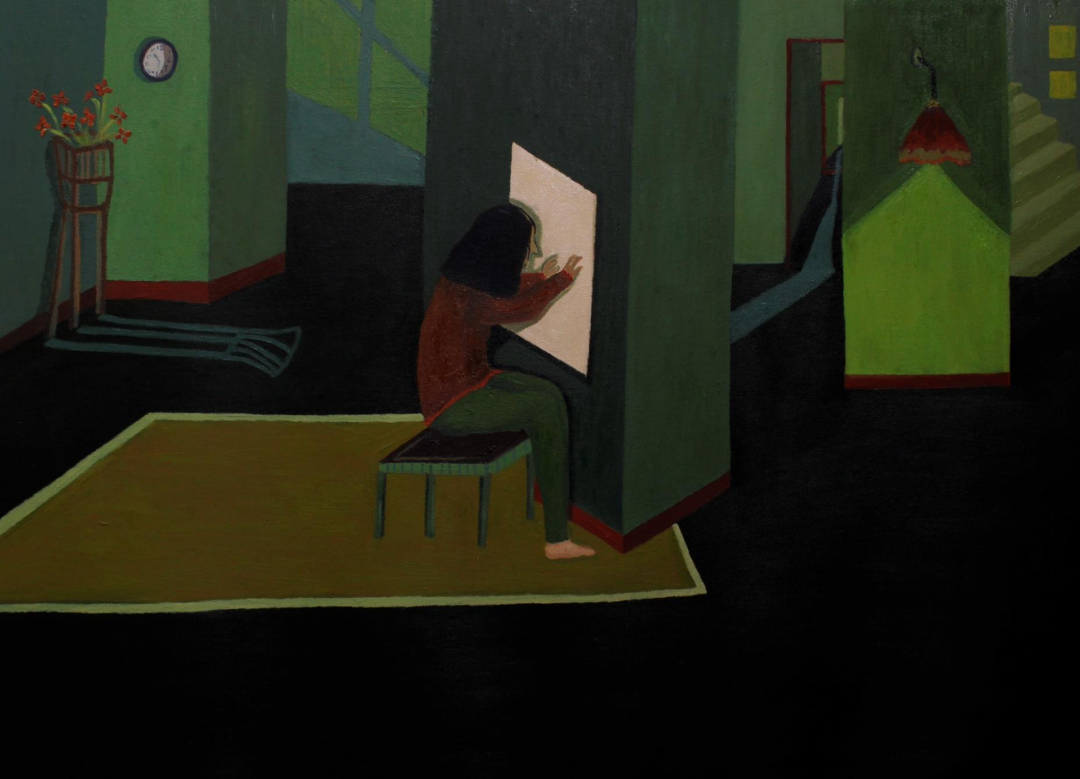For Singaporean artist Brandon Tay, the age of new media comes replete with its own newer inversions of digital space, spatialization, and perspective. Tay’s installation, FACADE, was part of F(r)iction@KONA, one of Indian art non-profit St+art India’s recent exhibitions on new media, and installation art. The exhibition also featured the work of artists such as Marc Lee, Martha Cooper and Akshat Nauriyal.
Tay’s installation is a meeting of the anthropomorphic with the interactive and the digitalized. Some would say, in the present state of affairs, the former implies the latter. The set-up features a screen reflecting back the viewer, who comes face to face with a creature bipedal but decidedly not human- with black fur covering a body crowned by a square of effervescent pink. While you stand before the installation, the creature, through a series of body sensors and object motion technology, mirrors your movements. Upon immediately entering the room, one encounters immediate darkness and the surprise of this creature mirroring movement. A number of other elements establish the frame as well, such as two hooded neon figures, who rest in the background. On the side we see another reflective surface, dancing enticingly: it is a smartphone.
A visitor to the installation describes the relatability striking when she realized how much the anthropomorphic creature’s imitation of the person viewing the frame reminded her of the nature of social media, wherein one is always moving as a reified version of the self, with the desire to appear a certain way, and the installation to her became a moving observance of the same.
There is certainly an element of the phantasmagoric imaginative in Tay’s installation, and St+art’s exhibit comes with an impressive line-up of artists who explore the phantasmagoric in and as new media, such as the work of Swiss artist Marc Lee who works cyberspace and alternative cartographies in his installation, Echo-location. Speaking of his use of new media and the inspiration behind his installation, one understands Brandon Tay’s use of form and motives are incredibly interlinked. He says, “Like most people, I consume my media through sub-optimal means- as tiny square videos on Instagram, or videos of videos on YouTube and Facebook. I guess that method of consumption takes away a lot of what a piece of art might look like in context, but at the same time, it condenses a moving image into its broadest strokes. I stumbled into new media art from a background in music videos, photography, and conventional animation. I was never the best in those fields so finding out there was something out there that combined all three, but was more inclusive than its constituent parts, was something of a lucky break.”
When considered in line with the visitor’s perspective of the installation, and Brandon Tay’s own reasons for the amorphous and mutable nature of new media art, a common tangent is the idea of social media informing a certain reception of artists, and art. The boundaries of viewership, how it is conducted, and its limitations become an alive metaphor in Facade- and in this, the idea of perspective as shaped by the arrival of digital mediums comes alive.
When conceptualizing the work, Tay comments on being heavily inspired by The Arnolfini Marriage, an early Renaissance masterpiece by Jan Van Eyck. While the painting brings to light the ambiguous relationship between the two individuals who occupy the frame, one’s attention is drawn to the back of the painting where rests a mirror, that reflects back the scene of what the two subjects of the painting see before them. This includes the artist’s own picturization of him in the frame. He becomes a present- absent in the painting, an inverted and consistent reckoning. The mirror in the back of the Arnolfini Marriage, in some sense, alters our perspective of the painting beyond the realm of something as straight as dimensionality. It reflects on the streamlined world of the characters in some sense looking beyond the painting, and thus looked upon by us, re-doubled, breaking down into a series of other angles. Although they are not, the complexity of relations between what is being viewed, the viewer and that which reflects back leaves one with the uncanny feeling of turning into a subject/ object to the figures in the painting.
This aspect turns interestingly asunder when we consider Brandon Tay’s installation, and the creature mirroring our movements. Says Tay, “ The figures of the reflected avatars were chosen for a certain playfulness, and reflects neutrality in terms of age, gender, or ethnicity. They do still have a kind of anthropomorphism in the sense that they have the arms and legs where humans might be, although in future iterations I might poke holes in that relationship a bit.”
The shape of the surface that does the reflecting, the one we meet, is part of a larger structure within the frame, which is a gold embossed inter-link to a larger network.
Even beyond the now hackneyed equation of social media’s looming intrusion in self-perspective, Brandon Tay’s installation explores the tenuous complexity of viewing through digitalized imagery and establishes the urban, anthropomorphic uncanny. The world on the other end of the installation feels very close to touch, particularly because of the mirroring, but remains, in the end, only a reflective surface to the one viewing Both a comment on how art comes to be consumed and viewed through “tiny squares”, as well as the unknowable nature of what the figures in the reflected, alternate world truly represent, Brandon Tay’s Facade is a compelling cosmos.
Photos by St+art India.
Text by Anandita Thakur.








